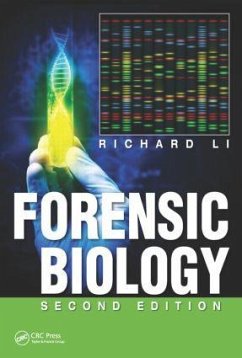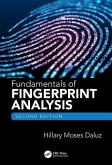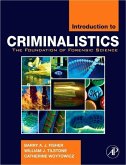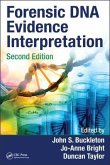Richard Li
Forensic Biology
Schade – dieser Artikel ist leider ausverkauft. Sobald wir wissen, ob und wann der Artikel wieder verfügbar ist, informieren wir Sie an dieser Stelle.
Richard Li
Forensic Biology
- Gebundenes Buch
- Merkliste
- Auf die Merkliste
- Bewerten Bewerten
- Teilen
- Produkt teilen
- Produkterinnerung
- Produkterinnerung
Focusing on forensic serology and forensic DNA analysis, this book introduces students to the methods and techniques utilized by forensic biology laboratories.
Andere Kunden interessierten sich auch für
![Fundamentals of Fingerprint Analysis, Second Edition Fundamentals of Fingerprint Analysis, Second Edition]() Hillary Moses DaluzFundamentals of Fingerprint Analysis, Second Edition186,99 €
Hillary Moses DaluzFundamentals of Fingerprint Analysis, Second Edition186,99 €![Ethics and the Practice of Forensic Science Ethics and the Practice of Forensic Science]() Robin T BowenEthics and the Practice of Forensic Science131,99 €
Robin T BowenEthics and the Practice of Forensic Science131,99 €![Introduction to Criminalistics Introduction to Criminalistics]() Barry A.J. FisherIntroduction to Criminalistics66,99 €
Barry A.J. FisherIntroduction to Criminalistics66,99 €![Forensic Evidence Management Forensic Evidence Management]() Forensic Evidence Management186,99 €
Forensic Evidence Management186,99 €![Forensic DNA Evidence Interpretation Forensic DNA Evidence Interpretation]() Forensic DNA Evidence Interpretation186,99 €
Forensic DNA Evidence Interpretation186,99 €![Medical Jurisprudence, Forensic Medicine and Toxicology; Volume 2 Medical Jurisprudence, Forensic Medicine and Toxicology; Volume 2]() Rudolph August WitthausMedical Jurisprudence, Forensic Medicine and Toxicology; Volume 241,99 €
Rudolph August WitthausMedical Jurisprudence, Forensic Medicine and Toxicology; Volume 241,99 €![A Handbook of the Practice of Forensic Medicine: Based Upon Personal Experience; Volume 2 A Handbook of the Practice of Forensic Medicine: Based Upon Personal Experience; Volume 2]() Johann Ludwig CasperA Handbook of the Practice of Forensic Medicine: Based Upon Personal Experience; Volume 232,99 €
Johann Ludwig CasperA Handbook of the Practice of Forensic Medicine: Based Upon Personal Experience; Volume 232,99 €-
-
-
Focusing on forensic serology and forensic DNA analysis, this book introduces students to the methods and techniques utilized by forensic biology laboratories.
Produktdetails
- Produktdetails
- Verlag: Taylor & Francis
- 2nd edition
- Seitenzahl: 568
- Erscheinungstermin: 5. März 2015
- Englisch
- Abmessung: 258mm x 193mm x 29mm
- Gewicht: 1397g
- ISBN-13: 9781439889701
- ISBN-10: 1439889708
- Artikelnr.: 39379647
- Herstellerkennzeichnung
- Libri GmbH
- Europaallee 1
- 36244 Bad Hersfeld
- gpsr@libri.de
- Verlag: Taylor & Francis
- 2nd edition
- Seitenzahl: 568
- Erscheinungstermin: 5. März 2015
- Englisch
- Abmessung: 258mm x 193mm x 29mm
- Gewicht: 1397g
- ISBN-13: 9781439889701
- ISBN-10: 1439889708
- Artikelnr.: 39379647
- Herstellerkennzeichnung
- Libri GmbH
- Europaallee 1
- 36244 Bad Hersfeld
- gpsr@libri.de
Richard Li
Biological Evidence. Crime Scene Investigation of Biological Evidence.
Crime Scene Bloodstain Pattern Analysis. Forensic Biology: A Subdiscipline
of Forensic Science. Sources of Biological Evidence. Basic Techniques in
Forensic Biology. Nucleic Acid Extraction. DNA Quantitation. Amplification
by Polymerase Chain Reaction. DNA Electrophoresis. Detection Methods.
Serology Concepts. Serology Techniques: Past, Current, and Future.
Identification of Biological Evidence. Identification of Blood. Species
Identification. Identification of Semen. Identification of Saliva.
Identification of Vaginal Secretions and Menstrual Blood. Identification of
Urine, Sweat, Fecal Matter, and Vomitus. Individualization of Biological
Evidence. Blood Group Typing and Protein Profiling. Variable Number Tandem
Repeat Profiling. Autosomal Short Tandem Repeat Profiling. Sex Chromosome
Haplotyping and Gender Identification. Single Nucleotide Polymorphism
Profiling. Mitochondrial DNA Profiling. Forensic Issues. Forensic DNA
Databases: Tools for Crime Investigations. Evaluation of the Strength of
Forensic DNA Profiling Results. Quality Assurance and Quality Control.
Crime Scene Bloodstain Pattern Analysis. Forensic Biology: A Subdiscipline
of Forensic Science. Sources of Biological Evidence. Basic Techniques in
Forensic Biology. Nucleic Acid Extraction. DNA Quantitation. Amplification
by Polymerase Chain Reaction. DNA Electrophoresis. Detection Methods.
Serology Concepts. Serology Techniques: Past, Current, and Future.
Identification of Biological Evidence. Identification of Blood. Species
Identification. Identification of Semen. Identification of Saliva.
Identification of Vaginal Secretions and Menstrual Blood. Identification of
Urine, Sweat, Fecal Matter, and Vomitus. Individualization of Biological
Evidence. Blood Group Typing and Protein Profiling. Variable Number Tandem
Repeat Profiling. Autosomal Short Tandem Repeat Profiling. Sex Chromosome
Haplotyping and Gender Identification. Single Nucleotide Polymorphism
Profiling. Mitochondrial DNA Profiling. Forensic Issues. Forensic DNA
Databases: Tools for Crime Investigations. Evaluation of the Strength of
Forensic DNA Profiling Results. Quality Assurance and Quality Control.
Biological Evidence. Crime Scene Investigation of Biological Evidence.
Crime Scene Bloodstain Pattern Analysis. Forensic Biology: A Subdiscipline
of Forensic Science. Sources of Biological Evidence. Basic Techniques in
Forensic Biology. Nucleic Acid Extraction. DNA Quantitation. Amplification
by Polymerase Chain Reaction. DNA Electrophoresis. Detection Methods.
Serology Concepts. Serology Techniques: Past, Current, and Future.
Identification of Biological Evidence. Identification of Blood. Species
Identification. Identification of Semen. Identification of Saliva.
Identification of Vaginal Secretions and Menstrual Blood. Identification of
Urine, Sweat, Fecal Matter, and Vomitus. Individualization of Biological
Evidence. Blood Group Typing and Protein Profiling. Variable Number Tandem
Repeat Profiling. Autosomal Short Tandem Repeat Profiling. Sex Chromosome
Haplotyping and Gender Identification. Single Nucleotide Polymorphism
Profiling. Mitochondrial DNA Profiling. Forensic Issues. Forensic DNA
Databases: Tools for Crime Investigations. Evaluation of the Strength of
Forensic DNA Profiling Results. Quality Assurance and Quality Control.
Crime Scene Bloodstain Pattern Analysis. Forensic Biology: A Subdiscipline
of Forensic Science. Sources of Biological Evidence. Basic Techniques in
Forensic Biology. Nucleic Acid Extraction. DNA Quantitation. Amplification
by Polymerase Chain Reaction. DNA Electrophoresis. Detection Methods.
Serology Concepts. Serology Techniques: Past, Current, and Future.
Identification of Biological Evidence. Identification of Blood. Species
Identification. Identification of Semen. Identification of Saliva.
Identification of Vaginal Secretions and Menstrual Blood. Identification of
Urine, Sweat, Fecal Matter, and Vomitus. Individualization of Biological
Evidence. Blood Group Typing and Protein Profiling. Variable Number Tandem
Repeat Profiling. Autosomal Short Tandem Repeat Profiling. Sex Chromosome
Haplotyping and Gender Identification. Single Nucleotide Polymorphism
Profiling. Mitochondrial DNA Profiling. Forensic Issues. Forensic DNA
Databases: Tools for Crime Investigations. Evaluation of the Strength of
Forensic DNA Profiling Results. Quality Assurance and Quality Control.








